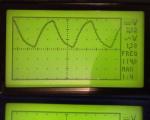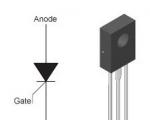How many lumens and what is the luminous flux in the lamp? What is luminous flux
In Soviet times, when choosing a light bulb, consumers were guided by the number of watts in it. The more of them - the brighter the light this device. However, today (when many new varieties of lamps have appeared on store shelves), we increasingly come across such a concept as “lumen”. What is it, how does it differ from a watt, and what is the unit called lumen per watt? Let's find the answers to these questions.
What is "lumen"
In the middle of the twentieth century. to avoid confusion in units of measurement between different countries, the universal SI system was introduced. It is thanks to her that we have watts, amperes, meters, kilograms, etc.
According to it, (visible electromagnetic radiation) is. In fact, these units measure the amount of light emanating from its source.
Also, to the question of what “lumen” is, you can answer that this is the name of a famous Russian rock band from Ufa. Having started its activity in 1998, for almost twenty years it continues to be loved by many listeners in Russian Federation and beyond.
Origin of the word
Having learned what a lumen is, it is worth clarifying where this word came from in the Russian language.
Like most of the names of units of measurement in the SI system, the term in question is Latinism. It is derived from the word for "light" (lūmen).
At the same time, some linguists argue that the noun could also be formed from the Proto-Indo-European word leuk (white) or from lucmen (the meaning is not exactly established).
What is the difference between lumen and lux
Considering the meaning of the word "lumen", it is worth mentioning such a concept close to it as "lux".

Both of these terms refer to light energy units, however, lumens is all the light emitted by the source, and lux is the amount that reached the illuminated surface, and was not stopped by some kind of obstacles with the formation of shadows.
The interdependence of these units can be reflected in the following formula: 1 lux = 1 lumen / 1 square meter.
For example, if a lamp illuminating an area of 1 m 2 emits 50 lumens, then the illumination of this place is 50 lux (50lm / 1m 2 \u003d 50 lux).
However, if the same lamp with the same amount of light is used for a room of 10 m 2, then the illumination in it will be less than in the previous case. Only 5 lux (50lm/10m 2 = 5 lux).
In addition, such calculations did not take into account the presence of various obstacles that prevent the light rays from reaching the surface, which significantly reduces the level of illumination.
In connection with this situation, in any country in the world there are lighting standards for various buildings. If it is below them, a person's vision does not receive enough light and deteriorates. For this reason, when planning to make repairs or rearrangements in your home, it is always important to take this nuance into account.
There are also a number of design programs in which such calculations are made automatically.
Lumen and watt
Having learned the difference and meaning of lumen and lux, you should pay attention to another unit of the SI system - watt.
Due to their use for light bulbs, some believe that these units can be freely correlated with each other. However, this is not quite true.
The fact is that in watts the power of energy that a light bulb consumes is measured, and in lumens it is the amount of light that it emits.
During the existence of only incandescent lamps, it was easier to calculate the amount of light from such a device. Since a 100 W light bulb gave out about 1600 lm of light. While a similar device at 60 W - 800 lm. It turned out that the more energy consumed, the better the lighting.
But today it's not like that. In recent decades, several new types of lighting sources have been invented (luminescent, etc.). Their advantage is economy. That is, they shine brighter with less energy used.
In this regard, if necessary, to draw up a relationship between watts and lumens, you need to take into account the type of lamp and look for its luminosity in special tables.

It is worth noting that an ordinary person sometimes does not want to rebuild and understand all these subtleties. Therefore, most domestic manufacturers new type light bulbs on the labels indicate not only the number of lumens, but how much less watts this device consumes (compared to an incandescent lamp). For example: a 12 watt lamp produces light as at 75 watts.
The unit of measure "lumens per watt": its meaning and scope

For example, a classic 40 W incandescent lamp has a light output of 10.4 lm/W. At the same time, for an induction lamp with the same power, this figure is much higher - 90 lm / W.
For this reason, when choosing a lighting device for your home, you should still not be too lazy, but find out the level of its light output. As a rule, such data is on the labels.
Ten years ago, choosing the right light bulb was easier, because incandescent bulbs were marked with maximum power. Currently, new LED-lamps are gaining more and more popularity. Select product required power in the modern era of lighting is more difficult, because LED lamps, compact fluorescent and other energy-saving lamps completely changed the power values. Now it will not be entirely correct to focus on watts, and it is not always possible. If in a regular store a specialist can still help you choose the right light bulb, then when making a purchase via the Internet, you are unlikely to find a watt in the description of this light bulb.
What is luminous flux?
Watts refer to the amount of energy consumed. For example, a 100W light bulb uses more energy than a 60W light bulb. This value indicates how much energy will be spent - it does not indicate the amount of light rays that the lamp gives. How much light you get from a light bulb shows 1 lumen.
Lumen is a unit of measurement luminous flux in the system of calculus. The brighter the light bulb, the larger this value will be. For example, a conventional 40 W incandescent lamp has a luminous flux of 300 lumens. Converting lumens to watts is not as easy as it seems.
The packaging of each product must contain information about how much light this product gives. When electrical energy is converted into light rays, some of it is lost and therefore large values are not achieved. It can be seen that this figure for incandescent lamps is 12 lumens per watt, while fluorescent lamps give 60 lumens per watt. LED lamps provide maximum illumination with minimum energy consumption - up to 90 lumens per watt.
Using this approach, it is not always possible to get the right results, because even bulbs of the same type with the same power can have a different ratio of luminous flux to energy costs, and the difference can be quite significant. Below is a table that allows you to convert watts to lumens for a lamp on first use. With its help, you can easily find out how many lumens are in an incandescent lamp, for example.

It follows from the table that a 600 lm LED lamp is not the equivalent of a 60 W incandescent lamp, and 1,000 lm is not the equivalent of a 100 W incandescent lamp.
Parameters that determine the luminous flux and its calculation
The beam consists of a stream of particles - photons. When these particles enter a person's eyes, certain visual sensations arise. The more photons hit the retina in a certain period of time, the more illuminated the object seems to us. Thus, the lamps emit a luminous flux of photons, which, falling into the eyes, allow us to clearly see objects in front of us.

Unfortunately, the longer the light bulb is used, the less brightness it can give. The lamp itself can also worsen the illumination indicator, because often the losses depend on the quality of the lamp material. The largest losses of the luminous flux are observed in gas-discharge sources, in fluorescent lamps these losses can be 20-30%, for incandescent lamps - 10-15%. LED lamps have the highest light output - light loss is less than 5%.
To convert the luminous flux of a lamp to lumens, use the average light output values:
- for diode products, multiply the power by 80–90 lm / W for light bulbs with a frosted bulb and get the light flux;
- for diode filaments (transparent products with yellow stripes) multiply the power consumption by 100 lm/W;
- multiply fluorescent energy-saving lamps by 60 lm / watt;
- for a HPS lamp, this value will be 66 lm / W for 70W; 74 lm/w for 100W, 150W, 250W; 88 lm/w at 400W;
- for an arc mercury lamp, the multiplier will be 58 lm / W;
- a 100 W incandescent lamp produces approximately 1,200 lumens. If the power is reduced to 40 W, the flux will reach 400 lm. But a 60 watt light bulb has an indicator of about 800 lm.
If you need to accurately determine the luminous flux, you will need a luxmeter device. It can be used to calculate , what luminous flux will be at the selected points of the room according to a known method.

One lux corresponds to a certain luminous flux falling on an illuminated surface of one square meter. You can determine the approximate value of the luminous flux created by a particular source using the formula:
F \u003d E x S,
where S is the area of all surfaces of the room you are examining (in square meters), and E is the illumination (in lux).
So if the surface area is 75 sq. meters, and the illumination is 40 lux, the luminous flux is 3,000 lumens. To accurately calculate the luminous flux, many other spatial factors will have to be taken into account.
If you choose the right LED lamp in all respects, subject to all the requirements of the manufacturer, it is guaranteed to last for many years. Currently, the least energy-consuming and most illuminating products are not cheap, but over time they will become available to all consumers.
When choosing an LED lamp, pay attention to the lumens to make sure you get the amount of light you need.
Usually we buy things based on the quantity we need, don't we? When we buy milk, we buy it in liters. Then why should light be different? For decades, we've bought light bulbs based on how much energy they use (watts) and not how much light they give us (lumens).
Lumen measures how much light you get from a light bulb. The more lumens, the brighter the light. Fewer lumens produce less light.
But the brightness and number of lumens can vary greatly, so there is a certain way to calculate the appropriate characteristics.
Practical calculation method:
- to replace a 100-watt incandescent bulb, look for an LED light bulb that will give 1100 lumens;
- 75-watt lamp - about 750 lumens;
- 60-watt lamp - about 550 lumens;
- A 40-watt lamp is about 200 lumens.
If you want something less bright, get LED bulbs with lower lumens.
Lighting Efficiency:
But we must not forget that Lumen is the total luminous flux from the source. However, this measurement does not usually take into account the focusing efficiency of a reflector or lens and is therefore not a direct parameter for evaluating the brightness or useful beam performance of a luminaire. A wide beam of light can have the same lumens as a narrow beam. Lumens cannot be used to determine the intensity of a beam because the lumen rating includes all stray and useless light.
Lux is a unit of measure for illuminance.
For example, 1 Lux is equal to the illumination of a surface with an area of 1 m² with a luminous flux of radiation incident on it equal to 1 lumen. If you collect 100 lumens and project them onto an area of 1 m², then the illumination of this area will be 100 lux. If the same 100 lumens are directed to 10 m², then the illumination will be 10 lux.
 Label for LED lamps:
Label for LED lamps:
What should be on the packaging when you buy LED lighting products?
To help consumers better understand the transition from watts to lumens, the Federal Trade Commission has proposed a new label for LED lamps. Such a label will help people buy light bulbs that are right for them.
Just like food labels, a lighting label helps consumers understand what they are really buying. The label clearly indicates: the luminous flux, the type of bulb, the price, the estimated cost of operation for the year and the color of the glow from warm white (with a yellowish tint) to cold white to cold (with a blue tint).
Instruction
According to the definition, an illumination of one lux creates a luminous flux of one lumen if it evenly illuminates a surface of one square meter. Therefore, to convert lumens to lux, use the formula:
Klux = Klumen / Km²
To convert lux to lumens, use the formula:
Klumen \u003d Klux * Km²,
where:
Klux - illumination (number of lux);
Klumen - value (number of lumens);
Km² - illuminated area (in square meters).
When calculating, keep in mind that the lighting should be uniform. In practice it is that all points on the surface must be equidistant from the light source. In this case, the light should fall on all parts of the surface at the same angle. Also note that the entire flux emitted by the light source must reach the surface.
If the light source is close in shape to a point, then uniform illumination can only be achieved on the inner surface of the sphere. However, if the luminaire is far enough from the illuminated surface, and the surface itself is relatively flat and has a small area, then the illumination can be considered almost uniform. A "bright" example of such a light source can be considered, which, due to its great distance, is almost a point source of light.
Example: A 100 W incandescent lamp is placed in the center of a cubic room 10 meters high.
Question: what will be the illumination of the ceiling of the room?
Solution: A 100 watt incandescent lamp produces a luminous flux of approximately 1300 lumens (Lm). This flow is distributed over six equal surfaces (walls, floor and ceiling) with a total area of 600 m². Therefore, their illumination (average) will be: 1300 / 600 = 2.167 Lx. Accordingly, the average illumination of the ceiling will also be equal to 2.167 Lx.
To solve the inverse problem (determining the luminous flux for a given illumination and surface area), simply multiply the illumination by the area.
However, in practice, the luminous flux generated by a light source is not calculated in this way, but is measured using special instruments - spherical photometers and photometric goniometers. But since most light sources have standard characteristics, use the following table for practical calculations:
Incandescent lamp 60 W (220 V) - 500 lm.
Incandescent lamp 100 W (220 V) - 1300 lm.
Fluorescent lamp 26 W (220 V) - 1600 lm.
Sodium discharge lamp (outdoor) - 10000...20000 Lm.
Sodium lamps low pressure - 200 Lm/W.
LEDs - about 100 Lm / W.
Sun - 3.8 * 10 ^ 28 lm.
Lm / W - an indicator of the efficiency of the light source. So, for example, a 5 W LED will provide a luminous flux of 500 Lm. Which corresponds to an incandescent lamp that consumes 60 W of power!
In recent years, approaches to the organization of lighting in everyday life and public spaces have changed smoothly and painlessly. Now you will not surprise anyone with LED lamps.
Stores sell LED and fluorescent fixtures, but the customer keeps 'wattage' in mind as the main metric for light sources. Prudent manufacturers, of course, indicate the power on the packages of LED products, what this can mean. Is it worth focusing on power and how to determine the correspondence between the types of devices?
For more information on the level of illumination that an LED light source produces, see the emission indicated in lumens. What do lumens mean in LED lamps, we will understand in this article.
What is Lumen
The concept of lumen was established by the international measurement system in the middle of the twentieth century.
Lumens measure the amount of total light emitted by a source. The parameter is directly related to the concept of luxury, but there is a difference between them.
Expert opinion
Alexey Bartosh
Ask an expertIt's important to understand! Lumen is the total amount of light that a source can emit in all directions. Lux is intended to indicate how much light hits a square meter of surface.
Therefore, if a lamp emitting 100 lm illuminates 1 m2 of the surface, then a flux equal to 100 lx will fall on it. If the same bulb shines in a room of 10 m2, then its illumination will be much lower. It is important to know that the calculations should take into account the entire luminous flux, in all directions.
In understanding this, one of the advantages of LED devices over incandescent lamps and fluorescent devices that glow in all directions is hidden. In diode lamps, the illumination angle approaches 120 or 180 degrees. With the help of built-in or external lenses, beams of any width are obtained.
 LED bulb inside
LED bulb inside Conclusion: the light flux is directed and used in the right direction, increasing its concentration.
Manufacturers actively use this feature in the development of LED lamps installed instead of halogen and xenon, d2s lamp, devices in car headlights. They are cheaper than xenon, load the electrics of cars less than halogen ones, not inferior in terms of illumination level.
Modern diodes are used to manufacture and replace 20 W lamps in position lamps and 55 W lamps in car headlights.
Parameters that determine the luminous flux and its calculation
For human perception, several indicators of luminous flux are important:
- The amount of total light emitted from a light source.
- Wavelength. It depends on how the eye perceives the brightness of light. Radiation in the middle, green part of the spectrum seems brighter than blue or red parts, with the same lamp power.
- Color temperature is measured in kelvins and must be indicated on packages and product data sheets. The picture shows the color temperature scale and the color of the emitted light.
Note! Warm colors are perceived by the human eye as less bright than cool colors. When buying "warm" lamps, make a small margin towards increasing power to create comfortable conditions in the room.
 Color temperature in comparison
Color temperature in comparison How many lumens in 1 W LED light bulb
Finding the right answer to a question is not easy. The fact is that manufacturers indicate the power and luminous flux for LEDs, not light bulbs. Real values can only be measured with special instruments. Focus on averages.
In general, when consuming 1 W of power, LEDs emit 90–100 lm. Expensive samples are able to "give away" 130-140 lm from one watt.
Under laboratory conditions, LEDs were obtained that give out 220 Lm / W, but devices are not produced on an industrial scale due to their high cost.
Reduces the efficiency of the built-in LED power driver, reducing the ratio of luminous flux to power by 5-10%. It is important to consider this when choosing and buying light sources.
Convert Lumens to Watts
For users who do not want to study the characteristics of electrical appliances and carry out calculations, there are many resources on the Internet with built-in calculators. It is enough to substitute the data provided by the manufacturer (lumens) and select the type of lamp to get the required power indicator.
The method of calculating the illumination for rooms
The calculation of the required number of lighting fixtures uses a simple technique.
The calculations are carried out in two stages:
- Calculation of the required luminous flux intensity.
- Determination of the number of lamps capable of providing the desired illumination.
Formula for an approximate calculation of the level of illumination, Lm.
Luminous flux \u003d normative indicator of illumination in lux (given in the table) * room area in m2 * ceiling height factor.
 Table 1. Norms of illumination
Table 1. Norms of illumination For ceilings up to 2.7 m, a coefficient of 1 is applied, with a room height of 2.7 to 3 m - a coefficient of 1.2, from 3 to 3.5 m - 1.5.
Calculation example. In the nursery, the illumination standard is set at 200 Lux. Room area 12 m2 Height 3.1 m - apply a coefficient of 1.2.
Multiplying 200 * 12 * 1.2, you get the required luminous flux of 2880 Lm.
Knowing the light indicator, they choose devices capable of providing it. For a given room, one 25-30 W LED lamp, or three 10-Watt sources, is enough.
Expert opinion
Alexey Bartosh
Specialist in the repair, maintenance of electrical equipment and industrial electronics.
Ask an expertImportant! For better illumination of the room, it is reasonable to use several lamps. This will evenly illuminate the room and get rid of the shadows.
Comparative characteristics of incandescent lamps and LED lamps
 Power usage various types light bulbs
Power usage various types light bulbs When comparing specifications all parameters speak in favor of diode devices.
Table 2. Comparison of the characteristics of LED and.
Regularly decreasing price LED bulbs, and the economic benefits from their use make the devices popular among buyers.
How many lumens in LEDs in relation to other light sources
Table 3. Average luminous flux for different power consumption.
LED lamps from trusted manufacturers have undeniable advantages when used in everyday life and at work. They are durable, economical, pay for themselves quickly. The ability to choose any shade of glow will make your stay in the room comfortable and safe.




